SINGAPORE – A new way to capture carbon dioxide (CO2) as it is produced has been devised by researchers here, and it can reduce the incineration waste sent to Singapore’s only landfill.
The solution provides a potentially new-use case for incineration ash – the by-product from burning waste – amid Singapore’s push to cut the waste sent daily to Semakau Landfill by 30 per cent by 2030.
With Semakau Landfill expected to reach full capacity by 2035, research is also under way to create new materials from incineration ash, so that less waste residue is landfilled.
By combining the captured CO2 with incineration ash, researchers from the Agency for Science, Technology and Research (A*Star), National University of Singapore and Nanyang Technological University have been able to create an alternative type of sand.
It can be used for land reclamation, building footpaths, and constructing coastal protection solutions like sea walls to guard against rising sea levels.
Dr Davin Tan from A*Star’s Institute of Sustainability for Chemicals, Energy and Environment, who is involved in the project, noted that while Singapore does have carbon-intensive industries such as the petrochemicals sector, the exhaust gas released from these plants often has a low concentration of CO2.
Singapore does not have many sectors which produce CO2 in high concentrations, he said, as industries like the concrete manufacturing sector are relatively small here.
While many industries like petrochemicals, industrial manufacturing and natural gas are carbon-intensive, the CO2 they emit is of lower intensity as the exhaust gas has been treated to reduce the amount of pollutants emitted, he added.
As capturing CO2 at low concentration is challenging, A*Star has developed a specially formulated liquid which can help intensify the concentration of the collected CO2.
Once concentrated, the CO2 is mixed with the incineration ash particles. It reacts to form a coating around the particles, creating a carbonate compound that effectively traps the planet-warming gas, said Dr Tan.
Associate Professor Pang Sze Dai from the National University of Singapore’s Department of Civil and Environmental Engineering, who is also involved in the research, said that incineration ash contains a range of compounds and heavy metals, but ash with higher calcium or iron content would be the most effective at creating the carbonate products.
Such ash can combine with CO2 to produce strong compounds, known as calcium and iron carbonates.
When many of these carbonate particles are amassed, large quantities of alternative sand can be produced.
Assistant Professor Paul Liu, from Nanyang Technological University’s School of Chemistry, Chemical Engineering and Biotechnology, who is also part of the team, is investigating the fundamental aspects of the chemical process to better understand the mechanisms through which the incineration ash reacts with the captured CO2.
Under normal conditions, the CO2 will remain trapped, and it would take very high temperatures – “hundreds of degrees” – for the carbonate to release the CO2.
The team is now scaling up production of alternative sand in the lab setting to produce a concrete-like brick, and is conducting a series of tests on it to determine its long-term stability.
This includes looking at how well the sand tolerates acidity, and whether any toxic metals could leach from it.
“We want to ensure that our product is entirely safe, is durable, and meets all the testing and certification requirements before we head to the commercialisation stage,” said Dr Tan.


